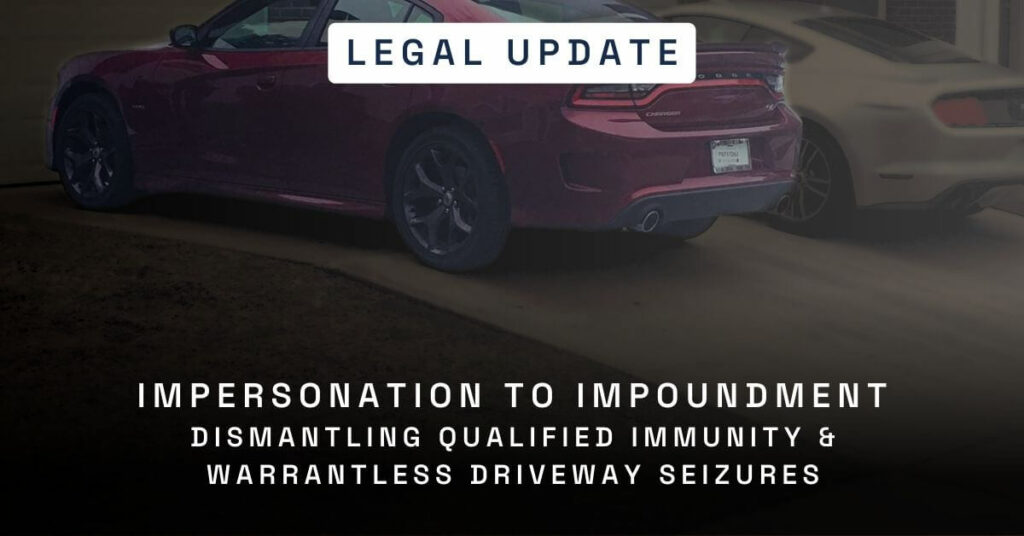In the landscape of modern law enforcement, a recent ruling from the Sixth Circuit Court has cast a spotlight on the complex interplay between the Fourth and Fourteenth Amendments and the doctrine of Qualified Immunity. The case in question, Habich v. Wayne County, was borne out of a contentious circumstance surrounding the impounding of a vehicle from a private driveway without a warrant.1
At the heart of the controversy was plaintiff Eugene Habich who, under the statute 42 U.S.C. § 1983, initiated a legal battle against two Wayne County deputies, John Wojciechowski and Christopher Mittlestat. Habich argued that his Fourth and Fourteenth Amendment rights were infringed upon when the deputies seized his vehicle from his property without obtaining a warrant.
The incident began with Habich driving a Dodge Charger which, incidentally, closely resembled an unmarked police vehicle. During a brief interaction with a Michigan Deputy Sheriff, Paul Spaulding, Habich used the Charger’s police-style lights to flash at the deputy. This behavior raised red flags, and, upon further investigation, it was discovered that the Charger was not affiliated with any law enforcement agency.
Days later, the suspicious Charger was located parked in Habich’s driveway, visible from the street. The deputies, Mittlestat and Wojciechowski, proceeded to question Habich and, after he admitted to using the Charger’s police-style lights on the highway, they seized his vehicle without a warrant, citing investigative purposes.
In the district court, Habich’s allegations were dismissed. The court asserted that Habich failed to demonstrate a violation of a constitutional right. Unwilling to accept this outcome, Habich took his case to the Sixth Circuit Court of Appeals, where the focus shifted onto the deputies’ seizure of the Charger.
In any legal challenge to a grant of qualified immunity, it’s incumbent on the plaintiff to establish two key points. Firstly, they must prove that the defendant violated a constitutional right. Secondly, they must demonstrate that the right was clearly established at the time of the violation.
In this instance, the Sixth Circuit was called upon not to decide on the constitutionality of the seizure, but to determine whether, in seizing Habich’s vehicle, the deputies violated a clearly established right.
Analysis & Implications
In the final analysis, the court ruled that Habich fell short in establishing that Deputy Mittlestat had violated a ‘clearly established right’.
To prove the violation of a clearly established right, a plaintiff must point to a case that would unequivocally place the officer on notice that his specific conduct was unlawful. In attempt to prove this violation, Habich cited two cases—Florida v. Jardines and Morgan v. Fairfield County—as precedents.2 However, the court determined that these cases were distinguishable from Habich’s situation, as they dealt with circumstances involving a front porch and concealed curtilage, unlike his own case where the interaction occurred in the driveway.
Moreover, the court upheld the legality of the deputies’ actions in impounding Habich’s Charger from the driveway without a warrant. The justification for this decision hinged on the car’s visibility and its placement outside of the home’s curtilage, the area immediately surrounding a dwelling that is part of the home for Fourth Amendment purposes. The Charger was parked alongside the front of the house and was a few feet from the house’s side. Additionally, the Charger’s police-style pushbar lights were clearly visible from the street.
The court affirmed the deputies’ right to impound Habich’s vehicle from the driveway without a warrant, given its visible placement outside the home’s curtilage. This distinction suggests that the specifics of the location and context can significantly influence the legality of warrantless seizures.
Conclusion
The Habich v. Wayne County ruling offers invaluable insights into the complex nature of qualified immunity and the legalities surrounding warrantless seizures. It’s a powerful reminder for officers to exercise critical judgement when encountering unique circumstances that might warrant a seizure or search.
While the Sixth Circuit ruling validated the officers’ right to seize a visibly parked vehicle from a driveway without a warrant, this should not be interpreted as a carte blanche permission for warrantless seizures. The key factors that swung the case in the officers’ favor included the Charger’s visibility, its distinctive police-style features, and its location outside the home’s curtilage.
Takeaways
For law enforcement officers, the guidance that can be gleaned from this ruling is to approach each potential seizure or search with due caution and consideration. Evaluating the unique circumstances of every encounter, such as the exact location and context of suspected illegal activity, is crucial.
Furthermore, when considering impounding a vehicle from a private driveway, it’s always advisable to err on the side of caution by seeking a search warrant, unless the circumstances clearly justify a warrantless seizure. This approach not only reinforces procedural correctness but also helps protect officers against potential legal complications.
The overarching theme remains: officers must strike a balance between carrying out their duty to enforce the law and respecting the constitutional rights of the individuals involved.
